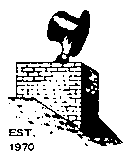Fireplace & Chimney Repairs Can Increase Your Home’s Energy Efficiency
Maintaining your furnace and chimneys regularly can save you a bundle in energy and replacement costs. Trust the qualified gas and heating product technician at John’s Chimney Service to inspect and repair your fireplace and furnace chimneys. If damaged components are left untreated, you may require a partial or full rebuild of the chimney. When components such as dampers and liners are faulty, they affect the venting process of the chimney. As a result, warm air can escape and cold air can enter the home. In addition, toxic gases and fumes can enter your home and fires can start inside chimneys as a result of creosote build-up.
Fireplace Dampers
A fireplace damper is located above the firebox and is used to seal off the chimney when the fireplace is not in use. Sealing off the chimney prevents heat from escaping and cold air from outside entering the home. In wood-burning fireplaces, the damper is made of cast iron and is able to withstand higher combustion temperatures. This durable material will not warp under extreme heat conditions.

Chimney Liners
Chimney liners are made up of different materials. The type of material that is used depends on the appliance it is serving. Most commonly, aluminum and stainless steel are used and can be corrugated to be flexible, in order to go around corners or rigid, when no bends are required. The importance of having a liner installed in your chimney is firstly, to prevent the products of combustion from entering the home, through cracks in the chimney. Even the best masonry chimney is not perfect. Secondly, liners provide proper sizing of the chimney to optimize the venting process. Chimney liners that are too small will not vent the appliance completely and may cause carbon monoxide build-up. Liners that are too big will create condensation build-up, sometimes causing water to drip at the base of the chimney.
The type of liner that is used depends on the appliance it is serving. Appliances that create higher combustion temperatures, such as wood-burning stoves and oil furnaces, must use stainless steel liners to prevent the material from melting under extreme heat combined with corrosive gases. Gas appliances have a much lower vent temperature and can use lower strength aluminum at a reduced cost.
Give us a call if you have any questions about liners or fireplace dampers, or would like a quotation for an installation. We will inspect your fireplace and chimney to identify areas for improved energy efficiency.
Contact us today to book your inspection or to learn more about our repair, gas line installation and cleaning services .
